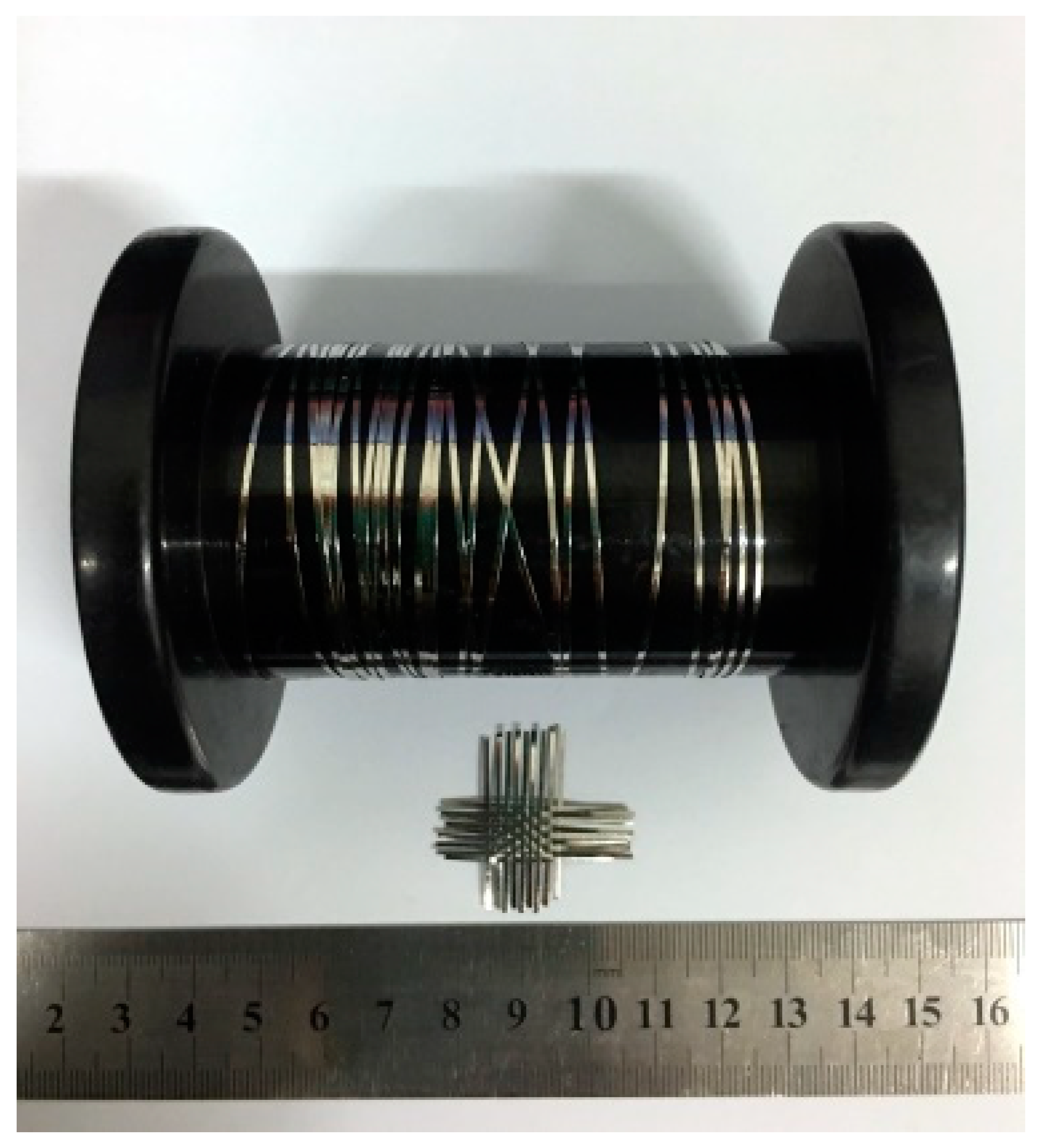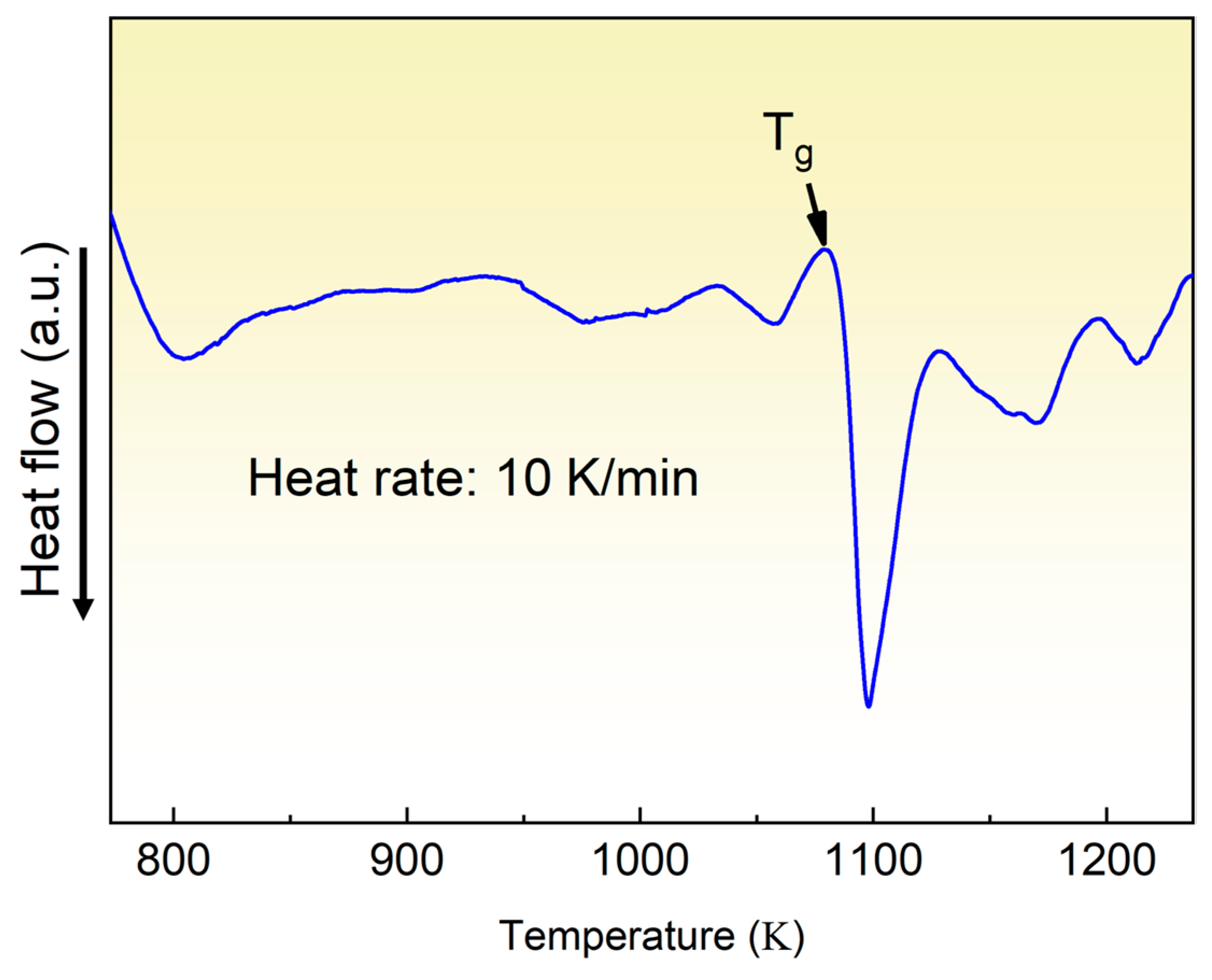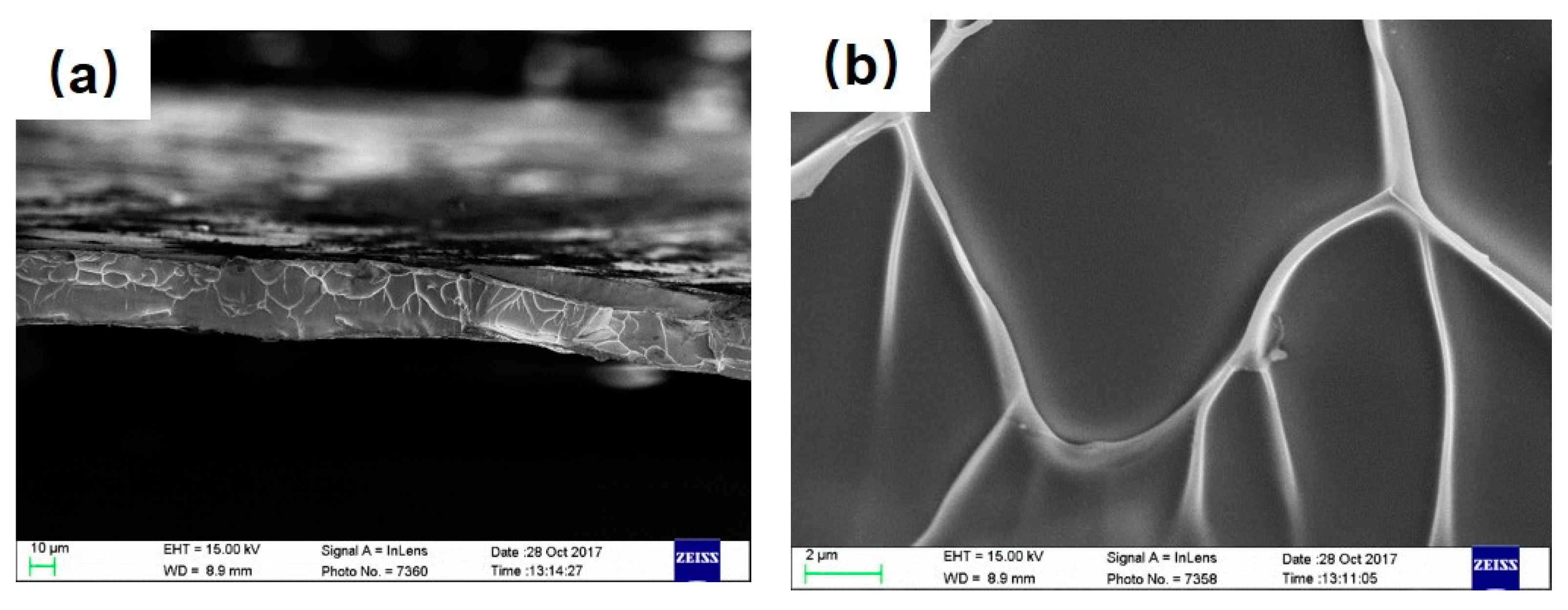Mechanical Response of Zr51.9Cu23.3Ni10.5Al14.3 Metallic Glass Ribbon under Varying Strain Rates
Abstract
:1. Introduction
2. Experiment
3. Results and Discussion
4. Conclusions
Author Contributions
Funding
Data Availability Statement
Conflicts of Interest
References
- Schuh, C.A.; Hufnagel, T.C.; Ramamurty, U. Mechanical behavior of amorphous alloys. Acta Mater. 2007, 55, 4067–4109. [Google Scholar] [CrossRef]
- Qiao, J.; Wang, Q.; Pelletier, J.; Kato, H.; Casalini, R.; Crespo, D.; Pineda, E.; Yao, Y.; Yang, Y. Structural heterogeneities and mechanical behavior of amorphous alloys. Prog. Mater. Sci. 2019, 104, 250–329. [Google Scholar] [CrossRef]
- Ming, W.; Guo, X.; Xu, Y.; Zhang, G.; Jiang, Z.; Li, Y.; Li, X. Progress in non-traditional machining of amorphous alloys. Ceram. Int. 2023, 49, 1585–1604. [Google Scholar] [CrossRef]
- Wang, A.; Zhao, C.; He, A.; Men, H.; Chang, C.; Wang, X. Composition design of high bs fe-based amorphous alloys with good amorphous-forming ability. J. Alloys Compd. 2016, 656, 729–734. [Google Scholar] [CrossRef]
- Wang, A.; Zhao, C.; Men, H.; He, A.; Chang, C.; Wang, X.; Li, R.W. Fe-based amorphous alloys for wide ribbon production with high bs and outstanding amorphous forming ability. J. Alloys Compd. 2015, 630, 209–213. [Google Scholar] [CrossRef]
- Parra, C.; Bolivar, F. Effect of cobalt addition on the microstructural evolution, thermal stability and magnetic properties of fe-based amorphous alloys. Vacuum 2019, 169, 108911. [Google Scholar] [CrossRef]
- Abrosimova, G.; Aronin, A. Nanocrystal formation in al-and ti-based amorphous alloys at deformation. J. Alloys Compd. 2018, 747, 26–30. [Google Scholar] [CrossRef]
- Chen, Q.; Yan, Z.; Guo, L.; Zhang, H.; Zhang, L.; Kim, K.B.; Li, X.; Wang, W. Enhancing the acid orange dye degradation efficiency of mg-based glassy alloys with introducing porous structure and zinc oxide. J. Alloys Compd. 2020, 831, 154817. [Google Scholar] [CrossRef]
- Martínez, C.; Briones, F.; Rojas, P.; Aguilar, C.; Guzmán, D.; Ordoñez, S. Microstructural and mechanical characterization of copper, nickel, and cu-based alloys obtained by mechanical alloying and hot pressing. Mater. Lett. 2017, 209, 509–512. [Google Scholar] [CrossRef]
- Xing, W.; Ouyang, D.; Li, N.; Liu, L. Estimation of residual stress in selective laser melting of a zr-based amorphous alloy. Materials 2018, 11, 1480. [Google Scholar] [CrossRef]
- Wang, X.; Zeng, M.; Nollmann, N.; Wilde, G.; Wang, J.; Tang, C. Thermal stability and non-isothermal crystallization kinetics of pd82si18 amorphous ribbon. AIP Adv. 2017, 7, 065206. [Google Scholar] [CrossRef]
- Chen, Q.; Yan, Z.; Zhang, H.; Zhang, L.; Ma, H.; Wang, W.; Wang, W. High mb solution degradation efficiency of fesibzr amorphous ribbon with surface tunnels. Materials 2020, 13, 3694. [Google Scholar] [CrossRef]
- Li, X.; Wu, J.; Pan, Y. Preparation of nanostructured cu/zr metal mixed oxides via self-sustained oxidation of a cuzr binary amorphous alloy. J. Mater. Sci. Technol. 2019, 35, 1601–1606. [Google Scholar] [CrossRef]
- Thorsson, L.; Unosson, M.; Pérez-Prado, M.T.; Jin, X.; Tiberto, P.; Barrera, G.; Adam, B.; Neuber, N.; Ghavimi, A.; Frey, M.; et al. Selective laser melting of a fe-si-cr-bc-based complex-shaped amorphous soft-magnetic electric motor rotor with record dimensions. Mater. Des. 2022, 215, 110483. [Google Scholar] [CrossRef]
- Zhou, S.; Zhang, T.; Li, L.; Yang, J.; Zhang, M.; Chengyong, W. Fatigue behavior of zr58cu15. 46ni12. 74al10. 34nb2. 76y0. 5 bulk metallic glass fabricated by industrial-grade zirconium raw material. Metals 2021, 11, 187. [Google Scholar] [CrossRef]
- Lin, J.; Wang, Z.; Cheng, J.; Kang, M.; Fu, X.; Hong, S. Evaluation of cavitation erosion resistance of arc-sprayed fe-based amorphous/nanocrystalline coatings in nacl solution. Results Phys. 2019, 12, 597–602. [Google Scholar] [CrossRef]
- Lamichhane, T.N.; Sethuraman, L.; Dalagan, A.; Wang, H.; Keller, J.; Paranthaman, M. Additive manufacturing of soft magnets for electrical machines—A review. Mater. Today Phys. 2020, 15, 100255. [Google Scholar] [CrossRef]
- Zhang, M.; Wang, Y.; Li, F.; Jiang, S.Q.; Li, M.; Liu, L. Mechanical relaxation-to-rejuvenation transition in a zr-based bulk metallic glass. Sci. Rep. 2017, 7, 1–12. [Google Scholar] [CrossRef] [PubMed]
- Khan, M.M.; Deen, K.M.; Haider, W. Combinatorial development and assessment of a zr-based metallic glass for prospective biomedical applications. J. Non-Cryst. Solids 2019, 523, 119544. [Google Scholar] [CrossRef]
- Su, X.; Hu, H.; Kong, X. The research progress of zr based amorphous composite materials. IOP Conf. Ser. Mater. Sci. Eng. 2017, 275, 012002. [Google Scholar] [CrossRef]
- Liu, L.; Ma, J.; Yu, C.; Huang, X.; He, L.; Zhang, L.; Li, P.; Liu, Z. Determination of forming ability of high pressure die casting for zr-based metallic glass. J. Mater. Process. Technol. 2017, 244, 87–96. [Google Scholar] [CrossRef]
- Marattukalam, J.J.; Pacheco, V.; Karlsson, D.; Riekehr, L.; Lindwall, J.; Forsberg, F.; Jansson, U.; Sahlberg, M.; Hjörvarsson, B. Development of process parameters for selective laser melting of a zr-based bulk metallic glass. Addit. Manuf. 2020, 33, 101124. [Google Scholar] [CrossRef]
- Zhou, W.; Meng, Y.; Duan, F.; Huang, W.; Yao, J.; Pan, J.; Wang, Y.; Li, Y. The effect of oxygen on phase formation in an industrial zr based bulk metallic glass. Intermetallics 2021, 129, 107055. [Google Scholar] [CrossRef]
- Dong, F.; Chu, Y.; He, M.; Zhang, Y.; Li, W.; Liaw, P.; Wang, B.; Luo, L.; Su, Y.; Ritchie, R. Manipulating internal flow units toward favorable plasticity in zr-based bulk-metallic glasses by hydrogenation. J. Mater. Sci. Technol. 2021, 102, 36–45. [Google Scholar] [CrossRef]
- Li, M.; Jiang, M.; Ding, G.; Peng, Z.; Jiang, F.; He, L.; Sun, J. The correlation between weakest configurations and yield strength of zr-based metallic glasses. J. Non-Cryst. Solids 2017, 468, 52–57. [Google Scholar] [CrossRef]
- Li, M.; Jiang, M.; Li, G.; Sun, J.; Jiang, F. Ductile to brittle transition of fracture of a zr-based bulk metallic glass: Strain rate effect. Intermetallics 2016, 77, 34–40. [Google Scholar] [CrossRef]
- Yu, W.; Zeng, H.; Sun, Y.; Sun, Y.; Hua, Z. Effect of heating rates on the crystallization process of fe64co16zr10b10 amorphous alloy. Phys. Lett. A 2017, 381, 1573–1576. [Google Scholar] [CrossRef]
- Bian, X.; Sun, M. Thermal-rate treatment and critical thickness for formation of amorphous al85ni10ce5 alloy. Mater. Lett. 2003, 57, 2460–2465. [Google Scholar] [CrossRef]
- Lin, S.; Chen, S.; Chen, J.; Lin, Y. Formation and magnetic properties of fe–si–b–dy amorphous alloy. Intermetallics 2010, 18, 1826–1828. [Google Scholar] [CrossRef]
- Zhang, J.; Teng, X.; Xu, S.; Xingjing, G.; Leng, J. Temperature dependence of resistivity and crystallization behaviors of amorphous melt-spun ribbon of mg66zn30gd4 alloy. Mater. Lett. 2017, 189, 17–20. [Google Scholar] [CrossRef]
- Sun, Y.; Qu, D.; Huang, Y.; Liss, K.; Wei, X.S.; Xing, D.W.; Shen, J. Zr–cu–ni–al bulk metallic glasses with superhigh glass-forming ability. Acta Mater. 2009, 57, 1290–1299. [Google Scholar] [CrossRef]
- Gu, J.; Duan, F.; Liu, S.; Cha, W.; Lu, J. Phase engineering of nanostructural metallic materials: Classification, structures, and applications. Chem. Rev. 2024; Online ahead of print. [Google Scholar] [CrossRef]
- Hossain, T. Mechanical Testing of Metallic Glass Ribbons. Master’s Programme in Mechanical Engineering (MEC). Master’s Thesis, Aalto University, Helsinki, Finland, 2021. [Google Scholar]
- Yüce, E.; Zarazúa-Villalobos, L.; Ter-Ovanessian, B.; Sharifikolouei, E.; Najmi, Z.; Spieckermann, F.; Eckert, J.; Sarac, B. New-generation biocompatible ti-based metallic glass ribbons for flexible implants. Mater. Des. 2022, 223, 111139. [Google Scholar] [CrossRef]
- Kouzoudis, D.; Samourgkanidis, G.; Tapeinos, C.I. Contactless detection of natural bending frequencies using embedded metallic-glass ribbons inside plastic beams made of 3-d printing. Recent Prog. Mater. 2021, 3, 1–12. [Google Scholar] [CrossRef]
- Tabbakh, T.; Kurdi, A.; Basak, A.K. Effect of strain rate and extrinsic size effect on micro-mechanical properties of zr-based bulk metallic glass. Metals 2021, 11, 1611. [Google Scholar] [CrossRef]
- Burgess, T.; Laws, K.; Ferry, M. Effect of loading rate on the serrated flow of a bulk metallic glass during nanoindentation. Acta Mater. 2008, 56, 4829–4835. [Google Scholar] [CrossRef]
- Fu, X.; Li, Y.; Schuh, C. Temperature, strain rate and reinforcement volume fraction dependence of plastic deformation in metallic glass matrix composites. Acta Mater. 2007, 55, 3059–3071. [Google Scholar] [CrossRef]
- Boltynjuk, E.; Gunderov, D.; Ubyivovk, E.; Monclús, M.; Yang, L.; Molina-Aldareguia, J.; Tyurin, A.; Kilmametov, A.; Churakova, A.; Churyumov, A. Enhanced strain rate sensitivity of zr-based bulk metallic glasses subjected to high pressure torsion. J. Alloys Compd. 2018, 747, 595–602. [Google Scholar] [CrossRef]
- Chen, T.-H.; Tsai, C.-K. The microstructural evolution and mechanical properties of zr-based metallic glass under different strain rate compressions. Materials 2015, 8, 1831–1840. [Google Scholar] [CrossRef]
- Zhang, J.; Park, J.M.; Kim, D.H.; Kim, H.S. Effect of strain rate on compressive behavior of ti45zr16ni9cu10be20 bulk metallic glass. Mater. Sci. Eng. A 2007, 449, 290–294. [Google Scholar] [CrossRef]
- Zhao, S.; Wang, H.; Gu, J.; Guo, N.; Shao, L.; Zhang, Y.; Yao, K.; Chen, N. High strain rate sensitivity of hardness in ti-zr-hf-be-(cu/ni) high entropy bulk metallic glasses. J. Alloys Compd. 2018, 742, 312–317. [Google Scholar] [CrossRef]
- Qin, F.; Xie, G.; Dan, Z.; Zhu, S.; Seki, I. Corrosion behavior and mechanical properties of mg–zn–ca amorphous alloys. Intermetallics 2013, 42, 9–13. [Google Scholar] [CrossRef]
- Wolff, U.; Pryds, N.; Johnson, E.; Wert, J. The effect of partial crystallization on elevated temperature flow stress and room temperature hardness of a bulk amorphous mg60cu30y10 alloy. Acta Mater. 2004, 52, 1989–1995. [Google Scholar] [CrossRef]
- Jayalakshmi, S.; Sahu, S.; Sankaranarayanan, S.; Gupta, S.; Gupta, M. Development of novel mg–ni60nb40 amorphous particle reinforced composites with enhanced hardness and compressive response. Mater. Des. 2014, 53, 849–855. [Google Scholar] [CrossRef]
- Pandya, K.S.; Roth, C.C.; Mohr, D. Strain rate and temperature dependent fracture of aluminum alloy 7075: Experiments and neural network modeling. Int. J. Plast. 2020, 135, 102788. [Google Scholar] [CrossRef]
- Yang, X.; Zhang, B. Material embrittlement in high strain-rate loading. Int. J. Extrem. Manuf. 2019, 1, 022003. [Google Scholar] [CrossRef]
- Ran, C.; Chen, P.; Li, L.; Zhang, W.; Liu, Y.; Zhang, X. High-strain-rate plastic deformation and fracture behaviour of ti-5al-5mo-5v-1cr-1fe titanium alloy at room temperature. Mech. Mater. 2018, 116, 3–10. [Google Scholar] [CrossRef]
- Sirigiri, V.K.R.; Gudiga, V.Y.; Gattu, U.S.; Suneesh, G.; Buddaraju, K.M. A review on johnson cook material model. Mater. Today Proc. 2022, 62, 3450–3456. [Google Scholar] [CrossRef]
- Shi, J.; Huang, Z.; Zu, X.; Xiao, Q.; Wang, Y. Research on non-cohesive jet formed by zr-based amorphous alloys. Sci. Rep. 2023, 13, 4149. [Google Scholar] [CrossRef]
- Nieh, T.; Schuh, C.; Wadsworth, J.; Li, Y. Strain rate-dependent deformation in bulk metallic glasses. Intermetallics 2002, 10, 1177–1182. [Google Scholar] [CrossRef]






| Strain Rate | Tensile Strength (MPa) | Elongation | Modulus |
|---|---|---|---|
| 1 × 10−3 s−1 | 980 | 2.4 | 40.0 |
| 1 × 10−4 s−1 | 1030 | 2.5 | 41.2 |
| 1 × 10−5 s−1 | 1200 | 2.8 | 42.8 |
Disclaimer/Publisher’s Note: The statements, opinions and data contained in all publications are solely those of the individual author(s) and contributor(s) and not of MDPI and/or the editor(s). MDPI and/or the editor(s) disclaim responsibility for any injury to people or property resulting from any ideas, methods, instructions or products referred to in the content. |
© 2024 by the authors. Licensee MDPI, Basel, Switzerland. This article is an open access article distributed under the terms and conditions of the Creative Commons Attribution (CC BY) license (https://creativecommons.org/licenses/by/4.0/).
Share and Cite
Li, D.; Wu, C.; Su, Y.; Xie, L.; Zhang, Y.; Wang, W. Mechanical Response of Zr51.9Cu23.3Ni10.5Al14.3 Metallic Glass Ribbon under Varying Strain Rates. Metals 2024, 14, 220. https://doi.org/10.3390/met14020220
Li D, Wu C, Su Y, Xie L, Zhang Y, Wang W. Mechanical Response of Zr51.9Cu23.3Ni10.5Al14.3 Metallic Glass Ribbon under Varying Strain Rates. Metals. 2024; 14(2):220. https://doi.org/10.3390/met14020220
Chicago/Turabian StyleLi, Dongyue, Chengshuang Wu, Yitian Su, Lu Xie, Yong Zhang, and Wenrui Wang. 2024. "Mechanical Response of Zr51.9Cu23.3Ni10.5Al14.3 Metallic Glass Ribbon under Varying Strain Rates" Metals 14, no. 2: 220. https://doi.org/10.3390/met14020220






